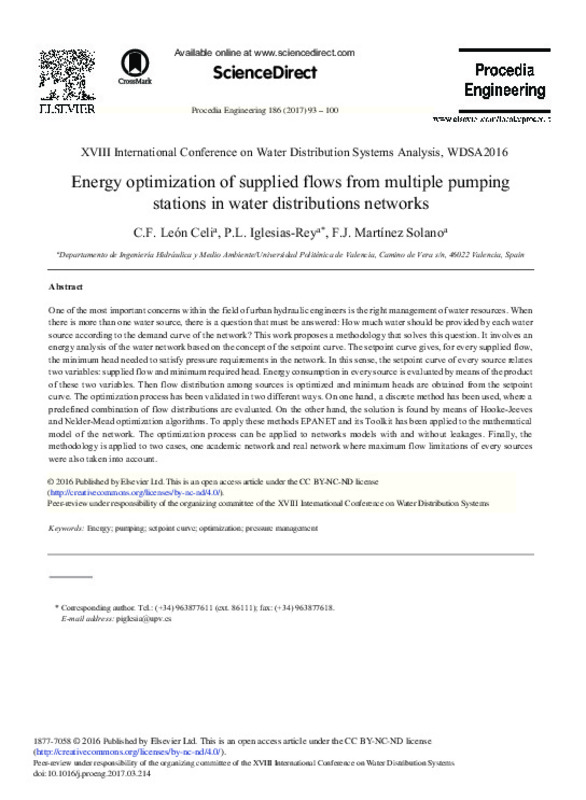JavaScript is disabled for your browser. Some features of this site may not work without it.
Buscar en RiuNet
Listar
Mi cuenta
Estadísticas
Ayuda RiuNet
Admin. UPV
Energy optimization of supplied flows from multiple pumping stations in water distributions networks
Mostrar el registro sencillo del ítem
Ficheros en el ítem
| dc.contributor.author | León Celi, Christian F.
|
es_ES |
| dc.contributor.author | Iglesias Rey, Pedro Luis
|
es_ES |
| dc.contributor.author | Martínez-Solano, F. Javier
|
es_ES |
| dc.date.accessioned | 2018-09-25T07:46:55Z | |
| dc.date.available | 2018-09-25T07:46:55Z | |
| dc.date.issued | 2017 | es_ES |
| dc.identifier.issn | 1877-7058 | es_ES |
| dc.identifier.uri | http://hdl.handle.net/10251/108102 | |
| dc.description.abstract | [EN] One of the most important concerns within the field of urban hydraulic engineers is the right management of water resources. When there is more than one water source, there is a question that must be answered: How much water should be provided by each water source according to the demand curve of the network? This work proposes a methodology that solves this question. It involves an energy analysis of the water network based on the concept of the setpoint curve. The setpoint curve gives, for every supplied flow, the minimum head needed to satisfy pressure requirements in the network. In this sense, the setpoint curve of every source relates two variables: supplied flow and minimum required head. Energy consumption in every source is evaluated by means of the product of these two variables. Then flow distribution among sources is optimized and minimum heads are obtained from the setpoint curve. The optimization process has been validated in two different ways. On one hand, a discrete method has been used, where a predefined combination of flow distributions are evaluated. On the other hand, the solution is found by means of Hooke-Jeeves and Nelder-Mead optimization algorithms. To apply these methods EPANET and its Toolkit has been applied to the mathematical model of the network. The optimization process can be applied to networks models with and without leakages. Finally, the methodology is applied to two cases, one academic network and real network where maximum flow limitations of every source were also taken into account. | es_ES |
| dc.language | Inglés | es_ES |
| dc.publisher | Elsevier | es_ES |
| dc.relation.ispartof | Procedia Engineering | es_ES |
| dc.rights | Reconocimiento - Sin obra derivada (by-nd) | es_ES |
| dc.subject | Energy | es_ES |
| dc.subject | Pumping | es_ES |
| dc.subject | Setpoint curve | es_ES |
| dc.subject | Optimization | es_ES |
| dc.subject | Pressure management | es_ES |
| dc.subject.classification | MECANICA DE FLUIDOS | es_ES |
| dc.title | Energy optimization of supplied flows from multiple pumping stations in water distributions networks | es_ES |
| dc.type | Artículo | es_ES |
| dc.type | Comunicación en congreso | es_ES |
| dc.identifier.doi | 10.1016/j.proeng.2017.03.214 | es_ES |
| dc.rights.accessRights | Abierto | es_ES |
| dc.contributor.affiliation | Universitat Politècnica de València. Departamento de Ingeniería Hidráulica y Medio Ambiente - Departament d'Enginyeria Hidràulica i Medi Ambient | es_ES |
| dc.description.bibliographicCitation | León Celi, CF.; Iglesias Rey, PL.; Martínez-Solano, FJ. (2017). Energy optimization of supplied flows from multiple pumping stations in water distributions networks. Procedia Engineering. 186:93-100. doi:10.1016/j.proeng.2017.03.214 | es_ES |
| dc.description.accrualMethod | S | es_ES |
| dc.relation.conferencename | 18th International Water Distribution Systems Analysis Conference (WDSA 2016) | es_ES |
| dc.relation.conferencedate | Julio 24-28,2016 | es_ES |
| dc.relation.conferenceplace | Cartagena de Indias, Colombia | es_ES |
| dc.relation.publisherversion | https://doi.org/10.1016/j.proeng.2017.03.214 | es_ES |
| dc.description.upvformatpinicio | 93 | es_ES |
| dc.description.upvformatpfin | 100 | es_ES |
| dc.type.version | info:eu-repo/semantics/publishedVersion | es_ES |
| dc.description.volume | 186 | es_ES |
| dc.relation.pasarela | S\355825 | es_ES |








